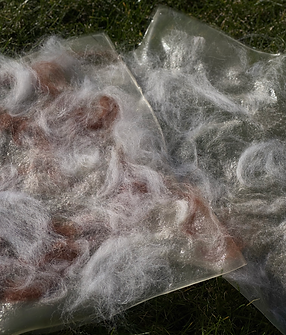
Nature Spine
"Nature Spine" is an innovative, biodegradable jewelry piece symbolizing the interconnectedness and resil-
ience of life. Crafted using eco-friendly materials like wool felt, each segment embodies strength and diversity
found in nature. The artistic use of avocado seed ink adds a unique touch, ensuring that every piece is
one-of-a-kind. The modular design allows "Nature Spine" to transform seamlessly from a spine to a choker,
encouraging adaptability and personal expression. By integrating modularity, waste is minimized, as each part
can be reheated to form new components. This flexibility allows for creative assembly, enhancing our connection to the natural world.

Manifesto
I am a fashion lover, but I have always believed there is a better way—one where fashion is sustainable and truly regenerative. Fashion has long been a source of creativity, identity, and expression, yet it has also contributed to environmental degradation. I refuse to accept that harm is an inevitable byproduct of beauty. Instead, I envision a world where fashion restores, renews, and regenerates rather than depletes.
Experiment
I have been exploring various natural materials to develop biodegradable fabrics, experimenting with different binders and recipes to optimize their properties. Initially, I used agar, which quickly solidifies upon cooling and, when dried, becomes quite rigid and hard, though it tends to shrink significantly during the drying process. In contrast, I experimented with gelatin-based formulations, which generally require more time to dry but offer minimal shrinkage and a smoother, more flexible texture. Through these trials, I am gaining valuable insights into how different natural binders influence the fabric's strength, flexibility, and overall properties, paving the way for more sustainable and eco-friendly textile alternatives.
Next, I experimented with adding different materials to my gelatin recipe. I started with avocado pit, which turned red when ground. Once dried, it formed a harder yet still brittle structure. I found the color intriguing and used the mixture to create a splash paint effect on one of my bio-fabrics, which worked well. I then incorporated pine needles, valued for their high fiber and lignin content. However, blending them in the lab proved challenging—achieving a fine powder was difficult. I tried refined powder, unfiltered needles, and a mix of both. I found that unfiltered needle pieces tended to break easily during processing.
I collected leftover felt from fashion students, which is easy to bend and increases the fabric’s strength. Adding more felt makes the material harder, making it ideal for my application. It also works well with Zund cutting, enabling modular design creation. I also tested palm tree husk from Quit, which creates a unique visual effect, but unfortunately, it is not suitable for Zund cutting.
Modular Components
In this exploration, I aim to investigate how to design modular bio-material components that enable users to experiment and create a wide range of accessory forms. By focusing on flexibility and innovation, I aspire to develop components that encourage creativity and personalization.
For my first prototype, I laser cut my bio-fabric into circles to create a bracelet. I successfully developed an interlocking mechanism using my 3D-printed mold. I plan to combine both locking systems to enhance functionality and versatility.




I developed a four-stage mold to design the interlock system for modular bio-material components. In the first prototype, the fabric would break too easily during demolding, and the grooved areas didn’t dry properly. The second prototype improved upon this by making the bio-leaf removable, allowing it to detach from the grooved areas. In the third iteration, I deepened the grooves for better hold and combined mold pieces to incorporate both holes and grooves. Finally, the fourth prototype achieved a robust, successful design, drawing inspiration from nature's spine structure to enhance stability and functionality.
I created and cut out shapes based on my designs to develop a paper prototype. This allowed me to test the size of each module and determine the quantity of modules needed to bring the product to life.

Product Development Phase
Bio-fabric making
Zund Cutting
Connecting & Coloring
Final Product








I incorporated a cross with three buttons on the back to connect the spine and choker, enabling users to remove the necklace themselves easily. This design allows for effortless detachment of the spine component, facilitating the transformation into a choker.

Exhibition at RCA Battersea








